How to properly plant tangerine at home
It is not difficult to grow a tangerine tree from a seed if you have the desire and free time. In order for the plant to please not only with foliage, but also with juicy fruits, it is grafted. This procedure requires compliance with certain rules. Let's look at how to plant a tangerine at home so that it bears fruit and care for it in the future.
Why does a tangerine tree need to be grafted?
Tangerine grafting is a mandatory procedure if you want grow a full-fledged tree with both a decorative crown and juicy fruits.
The procedure involves transferring a part of one plant to a second so that they grow together. As a result, the powerful root system of the rootstock ensures the growing season of the scion, a variety with the desired characteristics.
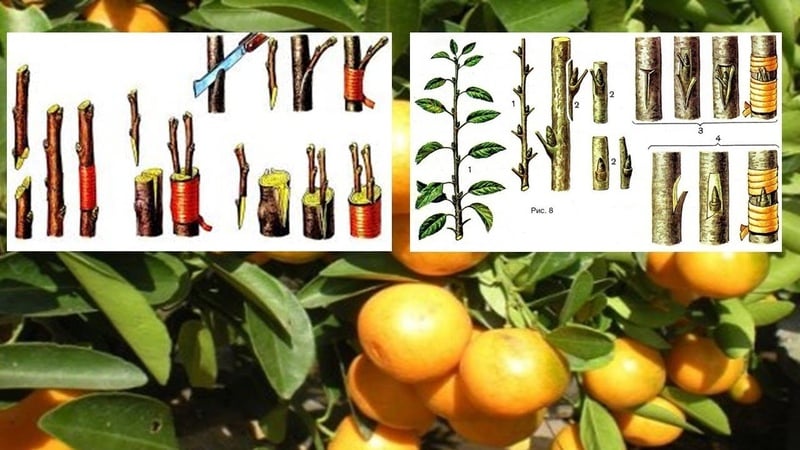
Graft:
- Accelerates the onset of flowering and fruiting. Successfully grafted mandarin Fruits abundantly 2-3 years after the procedure. In an ungrafted tree grown from a seed, fruits form in 7-10 years.
- Provides high-quality harvest in large quantities. The fruits of the scion, unlike the bitter fruits of the wild ones, are juicy and sweet in taste.
When to vaccinate
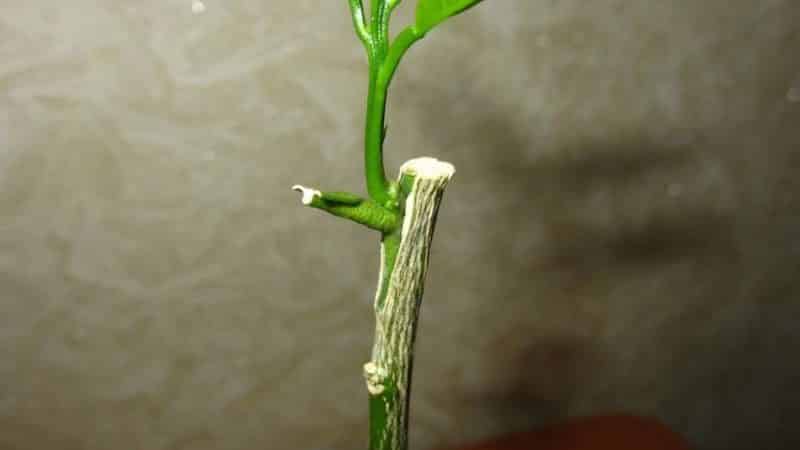
The optimal time for the procedure is the spring months. At this time, the tree wakes up and intense sap flow occurs. The bark is easily separated from the wood, which makes the operation easier. From March to May, the plant will safely tolerate the grafting and will become stronger after it, and the cuts will heal faster.
Reference! Grafting is possible in August, when the tangerine tree is full of strength.
Autumn and winter are the plant’s dormant period, when it is better not to injure it.
Basic methods of vaccination
There are three methods of grafting tangerines at home: by the bark, in the cleft, and with the eyes. All methods are quite simple, but require knowledge of the technology.
For the bark
How to graft a tangerine tree by the bark:
- A branch is cut from the rootstock and the bark is cut into about 3 cm.
- The edges of the bark are opened and a pointed scion with an oblique cut is placed there so that the surfaces of the plants are connected.
- Up to 3 scions are grafted onto powerful shoots at intervals of up to 4 cm from each other. If you graft in a circle, the tangerine tree will have a lush crown.
- The scion is fixed with electrical tape.
- The tree is placed in a greenhouse, periodically ventilated.
Into the cleft
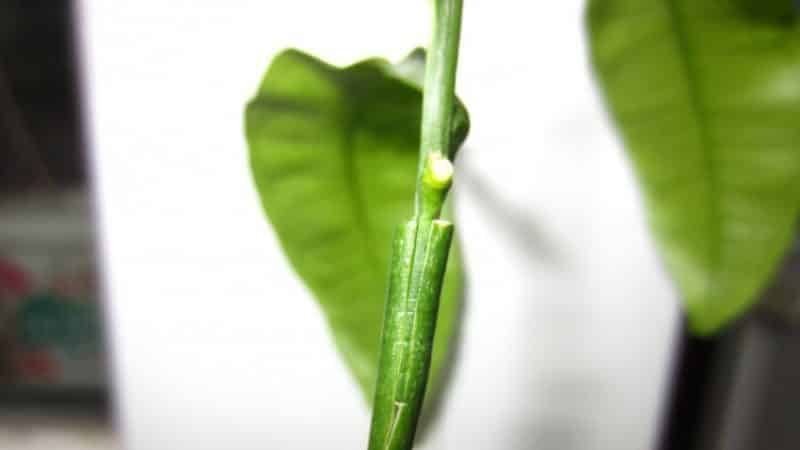
How to properly pinch a tangerine:
- On the rootstock, cut a branch at a distance of 10 cm above earth. The resulting stump is split to a depth of 3–5 cm.
- In the lower part of the scion (branches with buds) a wedge is formed by making two cuts at an angle 3-4 cm long.
- The wedge is inserted into the split so that the sections are tightly connected to each other on one side.
- The grafting site is secured with electrical tape.
- The tree is placed in a greenhouse from a bag or plastic bottle. To avoid rotting, the greenhouse is ventilated daily.
Budding
Budding, or grafting a tree with an eye (a single bud), is considered the most effective and least damaging method to the plant. Sequencing:
- The rootstock trunk is wiped with a damp cloth to remove dust.
- From the scion branch, carefully cut off the eye - the place of the bark with the bud.
- On the bark of the rootstock, a dissection is made with a sterile instrument at a distance of 6–10 cm from the ground surface in the shape of the letter T with a vertical strip of 1 cm and a horizontal strip of 2–3 cm.
- The bark on the tree is bent back with a knife, the peephole is placed inside and pressed down with the bark.
- Open areas are treated with garden varnish and wrapped with electrical tape so that the bud is open.
- Place the tree in a greenhouse for 15 days, which is ventilated daily.
- After a month, the apical stem of the rootstock is cut to 10 cm.
A sign of successful vaccination is the yellow color of the eye after 10 days.
Rules for grafting homemade tangerines
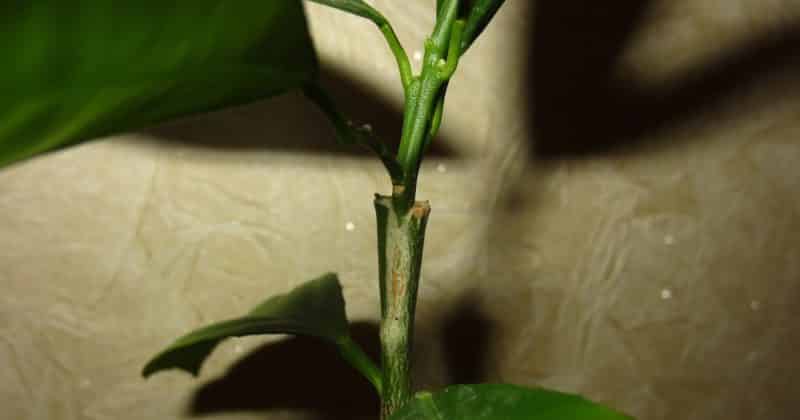
To plant tangerine at home without errors, it is important to follow the rules:
- the procedure is performed no more than 1-2 times a year;
- do everything quickly and clearly;
- all cuts and cuts must be smooth and clean, without nicks;
- Before the procedure, hands are thoroughly washed and instruments are disinfected;
- do not touch the cut: this will provoke infection of the rootstock;
- wounds on the plant are treated with garden varnish to avoid oxidation of the wood and rejection of the scion.
Preparation
To graft an indoor tangerine you will need:
- sharpened knife;
- insulating tape;
- garden var;
- plastic bag or plastic bottle;
- scion - a branch of fruiting citrus;
- rootstock - a tree grown from a tangerine seed.
A few days before the procedure, the tree is watered abundantly and checked whether the bark comes off freely by making a test cut over the site of future grafting.
Reference! Cooking recipe: rosin, beeswax and animal fat in a ratio of 4:2:1. The ingredients are boiled for half an hour, cooled and ground into a homogeneous mass.
It is better to carry out the procedure on a rainy day or in a room with high humidity: such conditions will prevent the scion from drying out.
Choosing a rootstock and scion
The rootstock - grown wild - must be healthy and strong. It is better to plant a tangerine older than 2 years: the plant needs that much time to form a root system and a fairly strong trunk 5–7 mm thick.
A twig of an adult fruiting citrus tree (tangerine, lemon or orange) with 2–4 buds is used as a scion. Related varieties adapt more easily and quickly. The thickness of the scion should be similar in diameter to the trunk of the rootstock.
Procedure
How to properly graft a tangerine:
- The rootstock is trimmed, leaving up to 10 cm above the ground. Before this, the area of the future cut is cleaned of dirt and dust with a rag.
- The scion is prepared: the petiole is cut off, leaving 2–4 mature buds. It is better to remove the leaves. The side of the scion that will touch the rootstock trimmed wedge
- In accordance with the chosen grafting method, either an incision is made on the bark or a split in the trunk.
- Insert the scion into the cut, tightly connecting the surfaces of the trunk and the cutting.
- Open areas are treated with garden varnish. The connection is tied with electrical tape.
- Place the tree in a greenhouse: put a bag or a cut plastic bottle on top.
It is important to combine the cambial layers (a thin ring under the bark) of the rootstock and scion, which are responsible for the growth of shoots in thickness and the formation of blood vessels. As a result, callus is formed around the sections - tissue that promotes the fusion of grafts.
Further care
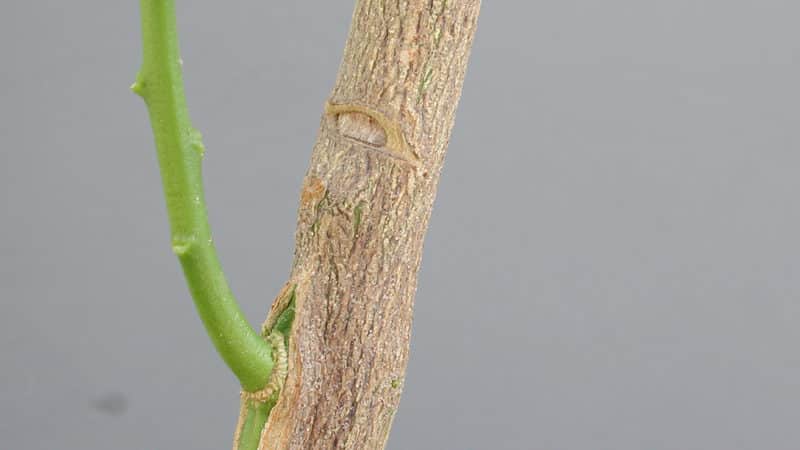
Recommendations for caring for a tangerine tree immediately after grafting:
- for the first month, the plant is kept in a greenhouse from a bag or a cut plastic bottle to create optimal humidity, temperature and protection from drafts;
- to prevent rotting, the tree is ventilated every day, sun and air baths are given;
- the electrical tape is loosened after 2 weeks, and completely removed after a month;
- After bud germination, the tangerine trunk is shortened by cutting at an angle at a distance of 6–10 cm from the scion.
If successful, after 10–20 days the scion will be green or yellow and the joint will begin to grow together. If the scion does not take root, it turns black and rots.
Important! Such a tangerine is removed from the greenhouse, unbandaged, the scion is removed, and the cut area of the bark is treated with garden varnish.
In order for the tree to continue to grow and bear fruit, it must be properly cared for:
- Maintenance conditions: uniform lighting, sufficient amount of sunlight, air humidity from 50%, comfortable temperature: in the warm season - up to +20...+25°C, in the cold - within +5...+10°C.
- In summer, the plant is watered 2-3 times a week, in winter - 1 time, using settled or filtered water.
- Spray the bush with a spray bottle, in summer - every 2 days, in winter - once every 2 weeks.
- Special fertilizers for citrus fruits are applied 2-3 times a month during the spring-summer period.
- Tangerines up to 4 years old are replanted every year, adult plants - once every 2 years. They do this in the spring.
- Excess and damaged branches are pruned to improve fruiting and form a decorative crown. The trunk is periodically shortened.
- Winter is a period of rest. At this time, reduce the amount of watering and fertilizing. The temperature is maintained within +15°C.
To prevent diseases, once every 2 months the crop is watered with a weak solution of potassium permanganate.
This is interesting:
Health benefits and harms of tangerines, energy value and rules of consumption.
Conclusion
Tangerine grafting guarantees abundant flowering and fruiting.To do this, choose one of three methods: into a split, behind the bark or budding. Complete and competent care of the plant ensures successful adaptation of the scion, the formation of common vessels and other tissues.